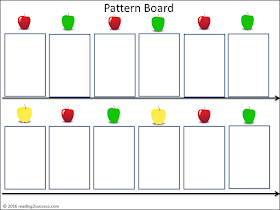Pattern boards and picture cards are a fun way to introduce children to patterning. Identifying patterns is an important skill for reading. Many patterns occur in words such as short vowel patterns, silent e patterns and vowel pairs. Recognized patterns help children decode unknown words. In the activity below, children are guided by small pictures on each pattern board. As children reference the small pictures they become successful in placing the cards in the correct order. Proceeding activities promote extension and creation of patterns!
In addition to the pattern boards, have children complete the practice papers to extend and create patterns. In the first two rows of each practice paper children are asked to circle the correct pictures to extend/complete the patterns. In the last row they have the opportunity to create their own pattern. In the example below (right side) Jade created a yellow, blue, red pattern. Another great activity is to place picture cards on popsicle sticks and have children manipulate the cards to create their own patterns! It's fun to see how many patterns can be created!
Below are practice pages to extend and create patterns
The first practice page is of fun brown, black and orange cats!
The second practice page is of delicious red, green and yellow apples!
The third practice page is of colorful blue, green and yellow backpacks!
Pattern board for cats.
Pattern board for apples
Pattern board for backpacks.
Cat cards for patterning board and popsicle stick activities.
Apple cards for patterning board and popsicle activities.
Backpack cards for patterning board and popsicle activities.
Create a learning center. Place magnets behind the back of apple, cat and backpack picture cards. Have children create different patterns!
Extension Activity of Sequencing and Retelling




























